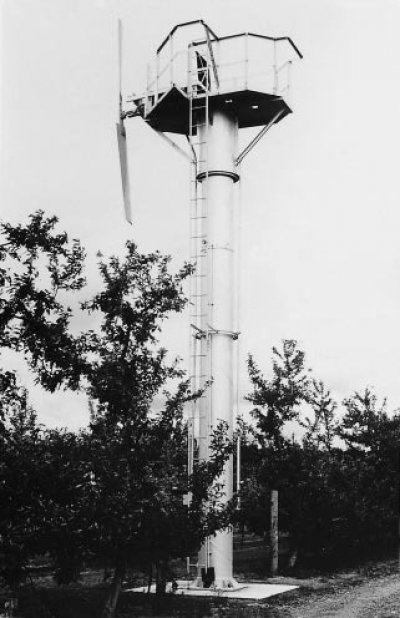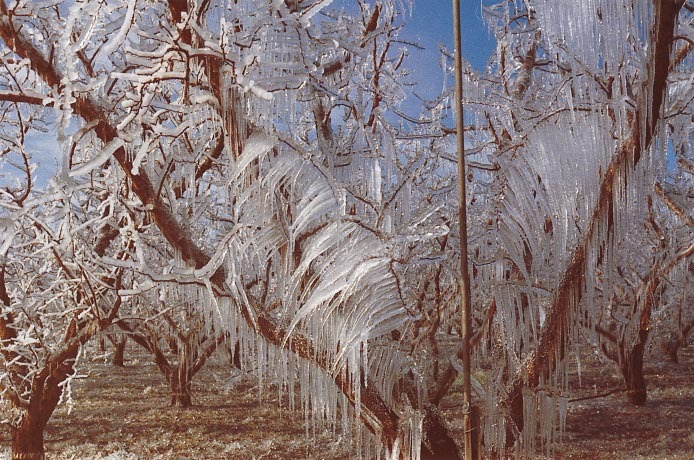Radiation frosts are common in some horticultural regions of Australasia caused by high radiation losses from earth to sky on still calm nights. The air at ground level becomes chilled by contact with radiating surfaces and drains downslope to low lying areas to form ‘frost pockets’ or ‘frost lakes’ that are commonly 5°C colder than the surrounding countryside. One related outcome, especially on calm mornings, is formation of a temperature inversion. Upper layers of air (30–50 m above ground) remain warmer (5–15°C) than the air at ground and tree level. Under these conditions, static wind machines (Figure 14.26) can be used to drive the warmer air down into the crop and over the soil surface, displacing the cold air and countering radiation heat losses. Given a consistent layer of warm air within reach of these fans, one wind machine every 5–7 ha will protect an orchard against temperatures down to about –3°C. A combination of clean burning oil heaters plus wind machines is even more effective. Helicopters are often used as mobile wind machines that move constantly to zones of low temperatures.
An alternative but remarkably effective method of alleviating frost damage relies upon the latent heat of freezing (see photograph below). Stored irrigation water, either from wells or ponds, is typically around 10°C, and as it cools on irrigated surfaces each gram of water will release about 10 calories of heat. On top of that, the latent heat of fusion adds a further 80 calories. In effect, a thousand litres of water supplies as much heat by this means as complete combustion of 12 L of oil.
The photograph shows both water and ice phases present on trees. While ice is continuing to form, plant tissues so encased will remain at 0°C, just above freezing point for plant tissues. This is above the threshold temperature for frost damage to sensitive buds, blossom and fruitlets. Overhead sprinklers are thus used with good effect to prevent frost damage, but application rate has to be closely controlled. Too little water and plants freeze, too much water and orchards become waterlogged, thereby exchanging one damaging condition for another. Application rates between 3 and 8 mm h–1 will generally suffice to prevent freezing damage to crops at air temperatures down to –6-8°C. Overhead sprinkling is not so effective in strong advective frost conditions, where cold winds cause evaporative cooling, thus reducing sprinkler efficacy.
References:
Raymond CA, Owen JV, Eldridge KG, Harwood CE (1992) Screening eucalpts for frost tolerance in breeding programs. Can J For Res 22: 1271-1277
Steponkus PI, Uemura M, Webb MS (1993) A contrast of the cryostability of the plasma membrane of winter rye and spring oat: two species that widely differ in their freezing tolerance and plasma membrane lipid composition. Adv Low-Temp Biol 2: 211-312
Wisniewski M, Lindow SE, Ashworth EN (1997) Observations of ice nucleation and propogation in plants using infrared thermograph. Plant Physiol 113: 327-334

